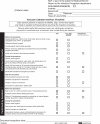Current strategies for the prevention and management of central line-associated bloodstream infections
- PMID: 21694903
- PMCID: PMC3108742
- DOI: 10.2147/IDR.S10105
Current strategies for the prevention and management of central line-associated bloodstream infections
Abstract
Central venous catheters are an invaluable tool for diagnostic and therapeutic purposes in today's medicine, but their use can be complicated by bloodstream infections (BSIs). While evidence-based preventive measures are disseminated by infection control associations, the optimal management of established central line-associated BSIs has been summarized in infectious diseases guidelines. We prepared an overview of the state-of-the-art of prevention and management of central line-associated BSIs and included topics such as the role of antibiotic-coated catheters, the role of catheter removal in the management, and a review of currently used antibiotic compounds and the duration of treatment.
Keywords: bloodstream infections; central venous catheters; guidelines; prevention.
Figures
References
-
- Kallen AJ, Patel PR, O’Grady NP. Preventing catheter-related bloodstream infections outside the intensive care unit: expanding prevention to new settings. Clin Infect Dis. 2010;51(3):335–341. - PubMed
-
- Maki DG, Kluger DM, Crnich CJ. The risk of bloodstream infection in adults with different intravascular devices: a systematic review of 200 published prospective studies. Mayo Clin Proc. 2006;81(9):1159–1171. - PubMed
-
- Merrer J, de Jonghe B, Golliot F, et al. Complications of femoral and subclavian venous catheterization in critically ill patients: a randomized controlled trial. JAMA. 2001;286(6):700–707. - PubMed
LinkOut - more resources
Full Text Sources


